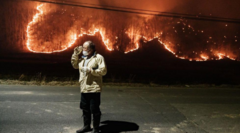The discovery of Tugunbulak and Tashbulak through lidar technology reveals high-altitude urban settlements, challenging previous assumptions about Silk Road trade routes and lifestyles of nomadic communities.
Ancient Highland Cities Unveiled Along the Silk Road

Ancient Highland Cities Unveiled Along the Silk Road
Archaeologists uncover two medieval cities in Uzbekistan's mountains, reshaping the narrative of the Silk Road through advanced technology.
Researchers have unearthed the ruins of two medieval cities nestled in the mountainous terrain of eastern Uzbekistan, a finding that has the potential to dramatically alter perceptions of the Silk Road. This pivotal trade route, historically associated with the lowland exchange of commodities and cultural ideas between East and West, is now recognized to include significant highland settlements as well. Utilizing advanced lidar (Light Detection and Ranging) technology, which maps three-dimensional environments through reflected light, archaeologists have identified at least two cities, including Tugunbulak, a vast urban area covering over 120 hectares and situated more than 2,000 meters (6,600 feet) above sea level—an elevation long regarded as inhospitable.
"The history of Central Asia is now evolving with this discovery," remarked archaeologist Farhod Maksudov from Uzbekistan's National Center of Archaeology, who contributed to the groundbreaking study. Tugunbulak and its smaller counterpart, Tashbulak, are thought to have thrived between the 8th and 11th centuries under a prominent Turkic dynasty, a period when such elevations housed only 3% of the global population. The research team, led by Maksudov and Michael Frachetti from Washington University in St. Louis, managed to publish their findings in the prestigious journal Nature. Experts, who were not directly affiliated with the research, praised the work as crucial for understanding the lives of potentially nomadic populations living in the mountains.
The team's journey began in 2011 when they discovered Tashbulak, compiling evidence including burial sites and numerous pottery shards. Historical references hinted at the existence of cities in this region; however, the discovery of a sprawling 12-hectare medieval city located at 2,200 meters elevation was unforeseen. Frachetti expressed astonishment regarding their challenging trek into these remote mountains, facing harsh weather conditions along the way. A significant break came four years later when a local forestry administrator mentioned the discovery of ceramics, leading the researchers to find that his house was situated directly atop a vast medieval citadel.
The formidable task of verifying the existence of these ancient cities posed challenges for the researchers, as many in the academic community were skeptical about their claims. "We would relay our findings and were often met with doubt, with some suggesting they were merely mounds or remnants of castles," Frachetti explained. In 2022, the application of a lidar-equipped drone allowed for the detailed imaging of Tugunbulak's architectural features, unveiling walls, guard towers, and other fortifications.
The team posits that the strategic location of Tugunbulak and Tashbulak may have attracted communities seeking to utilize strong winds for iron ore smelting, a resource-rich sector of the region. Initial excavations have also revealed production kilns that underscore the significance of iron during medieval times, as control over iron production indicated substantial power. However, this exploitation may have contributed to environmental degradation, leading to instability characterized by flooding and avalanches, as areas once thick with juniper trees were deforested for iron production.
Traditionally, academics have anticipated sites to be located lower in the valleys, making these findings all the more extraordinary, according to Peter Frankopan, a global history professor at Oxford University. He remarked, "What an extraordinary treasure trove... illustrating the extensive interconnections spanning Asia and the historical exploitation of natural resources." The existence of such high-altitude urban settlements is unprecedented and indicates unique challenges faced by these communities, according to Zachary Silvia of Brown University. His commentary in Nature emphasized that the team's findings considerably enrich our understanding of medieval urbanism in Central Asia.























